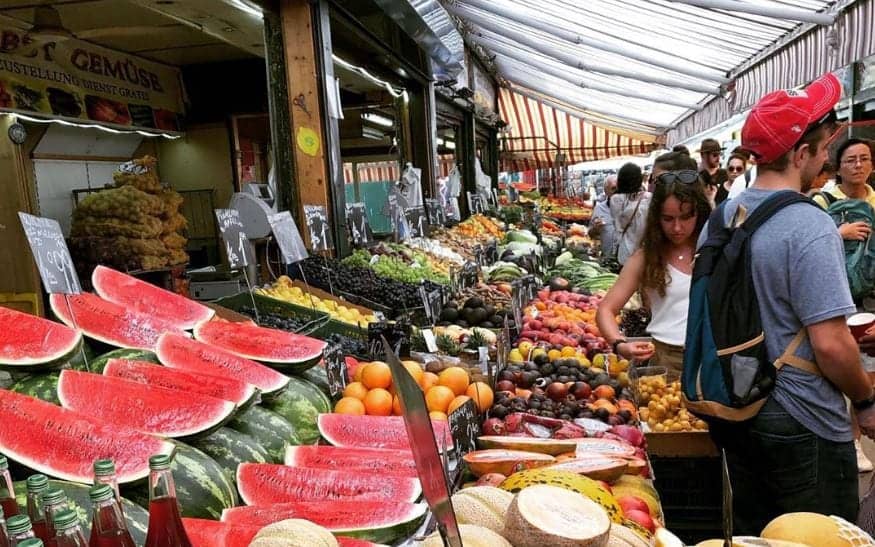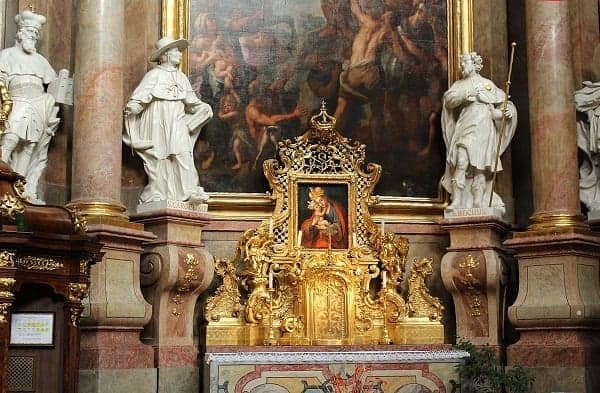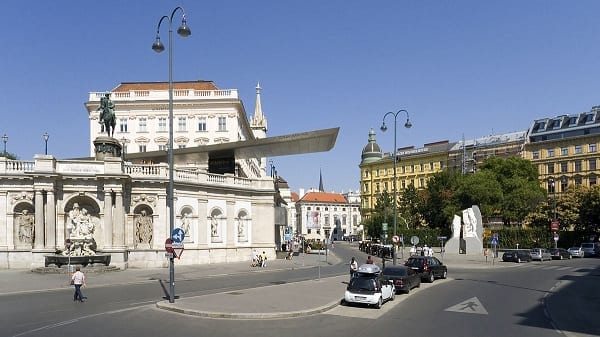For those seeking ideas to curate the most suitable 3 day Vienna itinerary, here is a handcrafted blog about maximizing your time in this vibrant metropolis in Austria.
Overview
Starting out in the cultural and historic "Inner City" (world heritage site), this itinerary takes you off the beaten path into contemporary Vienna’s art and social scene.
You may have already read our blog on 25 Things to Do in Vienna offering an exhaustive list for you to pick and choose from.
Here we have provided a detailed overview of the highlights of the city.

This itinerary will have you exploring the historical and cultural highlights and attractions in the "Inner City," enjoying an excursion to the Danube River, and more.
You might also find yourself hitting up a “Würstelstand” or even admiring some modern street art.
This post will lay out 3 unforgettable days for you and your family. We hope as you visit Vienna you'll find it as magical as we do.
Let's get started.
The first day of this itinerary will check some of the most notable highlights in Vienna off your list.
We'll start at Mozarthaus and move along through the city to several other historic sites.

See Mozarthaus
The Mozart House, located in the heart of the city's historic center, is the birthplace of composer Wolfgang Amadeus Mozart, and the place he lived until age 17.
During this time, he composed some of his earliest works, including his first symphony, sonatas, and operas.
The house has been preserved as a museum and has been restored to its 18th-century appearance. Visitors can see Mozart's bedroom, the living room, and other rooms where the family lived and worked.
The museum also contains a collection of musical instruments, including a fortepiano, as well as paintings, sculptures.
Other memorabilia includes original manuscripts and letters, Mozart's personal belongings, and various exhibits on his life and music.
Note that classical concerts can be attended in the house. Tickets for those can be found here.
Visit St. Stephen’s Cathedral or the Stephansdom
A quick walk from the Mozarthaus will take you to the stunning St. Stephen’s Cathedral, the home of the Catholic Church’s bishop in Vienna.
The cathedral's south tower is a commanding feature of the Vienna skyline, jutting up a full 446 feet (136 meters).
Tourists are able to climb up about halfway, up 343 steps, to the Türmerstube or Tower Room, which provides some great views of Vienna.
For those who prefer the use of an elevator, you can take one up the North Tower to a different observation tower.
The structure is as stunning as its history, as is the building’s fortitude through wars and tests of time.
You can walk through the interiors, for sure, but our favorite recommendation is to check out the catacombs.
Walk Through the Wien Museum
The Wien Museum (Vienna Museum) is located on Karlsplatz.
It's currently being renovated and expanded but it is expected to reopen in late 2023.
We absolutely love this dedicated building to the history and art of Vienna, one that celebrates the city’s notable residents over the ages.
View Karskirche
Located right by the Wien Museum is the 18th-century St. Charles Church, built mainly to celebrate the end of the plague in the city and to honor St. Charles, known to be the plague healer.
Could this be any more relevant in these Covid-19 times?
Take a Sightseeing Tour
There are several different types of tours available in Vienna that will take you to some of the most notable and historic locations in the city.
One of the easiest and most affordable options is to take a free walking tour
Alternatively, you can also take a hop-on hop-off bus tour which includes both commentary and transportation to and from many popular locations.
In addition to these outings, you can also take a sightseeing boat tour around the city!
Get pumped up for your second day in Vienna with a cup of coffee. Ok, let's add a small cake (Sachertorte) as well.
Today, we have planned for you a half day at the Schonbrunn Palace complex, followed by lunch.
In the late afternoon, get on a relaxing city river cruise and enjoy an evening ride on the Giant Ferris Wheel.
Schönbrunn Palace
A trip to Vienna cannot be complete without understanding the rise of the mightiest family in Europe, the Habsburgs.
Schönbrunn Palace was the main summer residence of the Habsburgs during the reign of Maria Theresa and the "glittering focus of court life".
Emperor Franz Joseph, who became Austria's longest-reigning monarch, was born here in 1830.
The palace has over 1,400 rooms, some of which can be visited. There is also a children's museum, an imperial carriage museum, a palace park, and a zoo.
Our post on Schonbrunn Palace provides information about tickets, guided tours, and more details about what can be visited.
Visit a Museum
There are a few museums to choose from in the area.
1. The Albertina Museum is a lovely art museum housed in the Hofburg Palace complex, the former principal imperial palace of the Habsburgs.
The Albertina has one of the largest print rooms in the world and boasts a varied collection, from Monet to Picasso.
The staterooms feature commanding architecture and a view into the luxury and opulence of lifestyle and furnishings.
2. Or you might enjoy the Sisi Museum, near Hofburg Palace, named after Empress Elisabeth of Austria, who was nicknamed Sisi.
Here you'll find the former imperial apartments, some of which can be visited.
There is an audience chamber, bedrooms, salons, dressing rooms, and more, all used by members of the Hapsburg family.
3. Or you can visit the Kunsthaus Wien. Hundertwasser Museum, which was founded by Friedensreich Hundertwasser, a 20th-century Austrian artist.
He was more than that, in fact, and eventually turned his attention to architecture, writing, model building, and more, all with a focus on how buildings can exist in harmony with man and nature.
The museum sits near Hunderwasserhaus (Hunderwasser House), an apartment building designed by Hundertwasser.
The building is characterized by its undulating façade, irregularly shaped windows, and use of bright colors and organic forms, which give it a unique and playful appearance.
Elements of nature, such as trees and vines, are woven into the architecture. The building's apartments are highly sought-after for their unique and playful design.
Hundertwasser Village, a former horse stable and tire factory that was renovated to include Hundertwasser's interior and interior designs, is across from Hunderwasserhaus.
Take a City River Cruise
With the Danube running through the city, a river cruise is a must.
It's relaxing and easy (especially with kids), and a welcome change from your heavy walk this morning.
There is a lot to look at including surprising facades with street art. Many tourist passes include this type of cruise.
VIENNA: DAY 3
We are suckers for art, as it brings to life the true vibe of a city. So today we have you visiting the Albertina first.
After that, according to us, the 7th District is the place to check out on your last day in Vienna.

Laden with alternative bars, music, people, artwork, and vintage photography, this is where the hip and cool are seen.
Also, if you plan to check out of your hotel or Airbnb today and need to store your luggage, you can find out all about it on our Luggage Storage in Vienna blog.
Visit the Museums at Belvedere Palace
Belvedere Palace, a magnificent example of Baroque architecture, is a complex of buildings that include two palaces, a new contemporary art museum, an orangery, stables, and extensive manicured French gardens with statues and fountains.
The Upper Belvedere showcases Austrian art from the Middle Ages to the 18th century. It is particularly famous for its collection of Austrian Baroque paintings, as well as its works by Austrian artists.
The museum has the largest collection of Klimt's paintings in the world.
The Lower Belvedere focuses on art from the 19th and 20th centuries. The museum's collection includes works by French Impressionists and Austrian modernists, including Monet, Degas, Renoir, Schiele, and Kokoschka.
It also features contemporary art, including works by Pablo Picasso, Joan Miró, and Salvador Dalí. Temporary exhibits are housed in the Lower Belvedere and the Orangery
You can sometimes find art in both Belvedere 21 and the Palace Stables as well.
Tickets can be found on some discount passes, or you can purchase them here.
Head to Prater Park and the Giant Ferris Wheel
At nearly 65 meters tall, it’ll be difficult to miss the giant Wiener Riesenrad (German for ‘Giant Wheel’) at the entrance of the Prater amusement park.
Although it was originally erected to celebrate the Golden Jubilee of Emperor Franz Josef I in 1897, it is still in operation to this very day.
If you want to ride one of the biggest, earliest Ferris wheels ever made, this is the place to go.
Purchase tickets or learn more.
There are also a number of restaurants near the park, so you'll find plenty of places to eat dinner.
Go to the Opera or a Classical Music Concert
Vienna is known worldwide as the capital of classical music, partly because so many fantastic composers (such as Mozart, Haydn, Strauss, and Beethoven) lived and wrote there.
The Vienna Philharmonic, founded in 1842, is one of the world's most renowned orchestras. It is known for its distinctive sound, which is characterized by a warm, rich tone, and for its artistic excellence.
The orchestra performs regularly at the Musikverein, the same place it holds it's annual New Year's Concert watched by millions of people around the world.
A few classical music concert options include:
- Vivaldi's Four Seasons in Karlskirche
- A Classical Concert at St. Stephen's Cathedral
- A Mozart Concert at the Golden Hall of Musikverein
- A Mozart and Strauss Concert in Schoenbrunn
The Vienna State Opera, also simply known as the Vienna Opera, is one of the world's most famous and prestigious opera houses. The Vienna State Opera House is located in the heart of Vienna and is considered one of the city's most iconic landmarks.
The company has a strong tradition of musical excellence and is renowned for its superb orchestral performances, choral singing, and top-notch soloists taking place in an auditorium with great acoustics.
Purchase tickets for the Vienna State Opera or learn more.
Here are a few extra tips to consider before heading out on this adventure.
Food
First things first, we take our food seriously when we travel, and so do the Viennese.
Start your day every day by trying out different traditional coffee houses (Kaffehaus). Whether it's Café Hawelka or Café Lantmen, coffee houses are rife with history and energy.
Sausage kiosks, or Wurstelstand, are a must-try and offer a range of sausages, from cheese-filled to spicy or smoked.
Incorporate the Original Viennese Apple Strudel Show at Schonbrunn Palace to experience apple strudel in the making. Note that if you have the Vienna City Card, you can save €1.
Be sure to indulge in a piece of Sachertorte, Vienna's famous chocolate cake. Sandwiched between two layers of genoise cake is apricot jam, all of it covered by a dark chocolate glaze. It can be found at Hotel Sacher.
Public Transportation
Vienna, Austria's capital, has an excellent public transportation system connecting inhabitants and visitors to various city regions.
Travelers may easily tour Vienna's attractions using trams, buses, and the U-Bahn, including historic sites, palaces, museums, and dynamic neighborhoods.
Read our post, Public Transit in Vienna, Austria which includes information on trams, buses, the metro, tickets, and helpful info on the City Airport Train.
Walking
Vienna is a great walking city. Many of the city's most famous landmarks are conveniently positioned in close proximity to one another and can be reached on foot.
We offer various Vienna walking tours where you can opt for free or paid tours.
Discount Passes
A great way to save a little bit of money is through the use of a discount pass such as the Vienna Pass.
With these passes, you can get free or reduced entry to some of the city's most well-known attractions, including the Kunsthistorisches Museum, the Albertina Museum, Hofburg Palace, the Sigmund Freud Museum, the Spanish Riding School, the Imperial Treasury, and so much more.
There is no one-size-fits-all answer to which pass is best.
It depends on the type of pass you need, how long you will be in Vienna, as well as whether you want public transportation and/or airport transfers to be included.
Our post, Which Vienna City Pass is Best, will walk you the various discounts and passes on offer.
Best Time to Visit
As the summer months are rather crowded (and expensive) and the winter months are cold, the best months to visit Vienna are in April and May and in September and October.
However, you won't want to miss the Christmas markets and all of the Viennese Christmas holiday traditions, so don't rule out a visit in November and December.
Our post, Christmas in Vienna, Austria will tell you more about what you might see during those months.
One thing you might enjoy is a Christmas and New Year's Concert in St. Peter's Church.
How Many Days in Vienna?
The length of time it takes to visit Vienna depends on your personal interests, preferences, and travel style. A typical stay in Vienna can range from a few days to a week or more.
If you are interested in experiencing the city's cultural and historical heritage, you may want to allow more time to visit Vienna's many museums, art galleries, and historical sites.
A one-day itinerary might include a visit to St. Stephen's Cathedral, the Imperial Palace, the Museum of Fine Arts, and a concert or opera performance in the evening.
If you are a food lover, you may want to spend more time exploring Vienna's dining scene and trying the city's famous pastries and coffee.
Additionally, if you are interested in outdoor activities, you can visit one of Vienna's many parks and gardens, such as the Schönbrunn Palace Gardens, or take a stroll along the Danube River.
Ultimately, the amount of time you choose to spend in Vienna will depend on your interests and the amount of time you have available for your trip.




